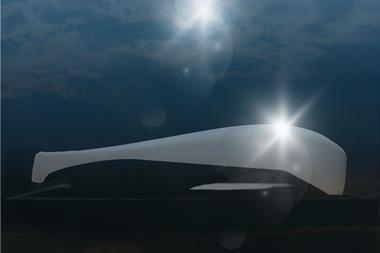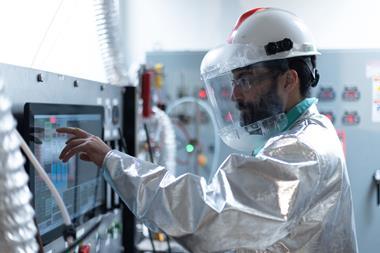BMW, Ford and Renault are incorporating composites and plastics in new models
To demonstrate that reduced weight and increased fuel efficiency are boosting the use of composites beyond their traditional use in niche manufacturing, look no further than BMW’s use of composites in its new i-series models; Ford’s inclusion of integrated plastic brackets, and Renault’s carbon fibre lift-gate.
The new range of electric vehicles from BMW may not signal a huge advance for EVs, but it is a giant step forward for the use of composites. The German carmaker believes that its entry into relatively high volume electric car production necessitates a totally new design and engineering approach, with the extensive application of industrialised CFRP. It is ten years since BMW first utilised CFRP for the roof of its CSL coupe’s roof, and later for the M3 roof and the M6 roof and bumper supports.
 “The only way we could achieve our weight targets was by using carbon fibre,” says project director Dr Carsten Breitfeld. “We have optimised the process, achieved a shorter manufacturing time and succeeded in taking a lot of the cost out.” BMW is convinced that many of the advances, including wider use of CFRP, demonstrated by its new subbrand will cascade into conventional vehicles.
“The only way we could achieve our weight targets was by using carbon fibre,” says project director Dr Carsten Breitfeld. “We have optimised the process, achieved a shorter manufacturing time and succeeded in taking a lot of the cost out.” BMW is convinced that many of the advances, including wider use of CFRP, demonstrated by its new subbrand will cascade into conventional vehicles.
The core of the i3 – quite literally – is its CFRP Life Module. Having a mass of 150kg, it is the result of a determined BMW and SGL campaign to cut the costs of the material’s manufacture and increase its application in automotive production with reduced cycle times but without quality degradation. The production process of the i3 begins with the fibre bundles from SGL being sent to the site at Wackersdorf Innovation Park, where they are processed into light textile fabrics on an industrial scale. The fibres are positioned side by side on one level, not interlaced. It is this fibre alignment in the fabric that provides required characteristics.
The fabrics are then transported to pressing plants in Landshut and at the Leipzig vehicle production plant. They undergo a pre-forming process, with a heating tool facilitating a stable, three-dimensional form for components to be assembled into a whole. This allows manufacture of large body components that would be very difficult to produce in aluminium or sheet steel. After finishing and pre-forming comes resination under high pressure via RTM, with liquid resin injected into preformed work pieces under pressure to bond the resin with a hardening agent and achieve curing.
Traditionally Ford has used separate hood bump-stops and headlamp attachment brackets with steel components. However, it has now adopted a new one-part plastic design, which is an industry first, it says. The technology debuted in the Ford Fusion launched in the US last year and aside from the prestige of being an industry first, it was also crowned winner in the safety category at the 42nd annual SPE Innovation Awards Gala, sponsored by the Automotive Division of the Society of Plastics Engineers, last November.
By using this integrated plastic bracket, the Head Injury Criterion (HIC) is reduced by approximately 30% of its original value, says Ford, which enables it to meet the Pedestrian Protection (PedPro) target, a new requirement for the US automotive market. Further benefits of this innovative design include flexibility - the design can be used on other vehicles – and a reduction in assembly complexity because it only consists of one part.
The material used was Styron’s Inspire long glass-fibre polypropylene resin (LGF PP). The company was part of a multi-collaborative development project with partner system supplier Magna Exterior and toolmaker Advantage Mold. Inspire is a polypropylene reinforced with 30% of long glass fibres that provides high stiffness, strength and impactresistance to the injection moulded part. The addition of glass fibres to the material proved crucial in order to meet the performance requirements of the integrated plastic bracket which is a structural, under-the-hood application that has to be flexible to reduce impact, while simultaneously having the ability to withstand tensile stress.
“Safety is one of the megatrends driving the automotive industry and one of Styron’s key innovation areas,” says Rodrigo Covarrubias, account manager at Styron Automotive. “Ford’s innovative plastic bracket shows how increased use of plastics gives car manufacturers more options and allows for safer, better performing vehicles.
“Inspire was the appropriate material to create the integrated plastic bracket. This high performance grade has unique properties to improve its impact resistance and durability. Whereas previously the bracket consisted of steel components, Ford has succeeded in developing a fully integrated plastics solution that not only reduces the total weight of the application, but is also easier to process.”
Renault’s mono-material lift-gate
Styron has also produced what it claims is the first fullthermoplastic, mono-material lift-gate. The lift-gate on the new Renault Clio is part of a long relationship between Styron and Renault, says the company. The target was a weight reduction of 10% from a product that would also be easily recyclable. To achieve this, process simulation was conducted at Styron’s global Application Engineering & Design Centre (AEDC).
After a two-year development project with Styron, Renault is now launching the new Renault Clio with a thermoplastic lift-gate made with Styron’s material solutions. The lift-gate is manufactured in thermoplastic from three separate parts.
“The automotive industry has been looking for alternatives to steel for lift-gates for many years,” says Marjolein Groeneweg, marketing manager at Styron Automotive. “Weight savings, styling freedom and function integration are the main objectives. With this innovative concept, jointly developed by Renault and our R&D department, the French car manufacturer not only contributes to weight reduction for optimal fuel efficiency, but also responds to waste management recycling guidelines promoting recyclability without disassembly. The part can be easily recycled and used in other future applications.”
A lift-gate is a complex application for several reasons; it needs to fit perfectly on to the car and has numerous functions that need to be hidden (such as the hinges and the closing mechanism). Additionally, it is subjected to external conditions such as high and low temperatures, and a humid environment that can cause deformation issues which must then addressed to guarantee water tightness.
To help improve impact resistance, expansion and durability of the structural part of the lift-gate, Styron’s engineers introduced LGF-PP. By increasing the glass content of the moulding material, the part is able to gain improved stiffness and toughness.

Styron also supported Renault in optimising the tool design for its machine, and specifically supported it by selecting the appropriate plasticising screw to maintain the required fibre length after moulding the lift-gate. Choosing a material composition and manufacturing process that achieves the desired glass fibre length distribution is critical to meeting the specific performance requirements of Renault’s lift-gate, says the company.
Styron said it had previously worked on the structure development for the front-end carrier of the VW Golf using LGF-PP. This exterior application had similar complexity issues in design as well as the production process – it consisted of different metal and thermoplastic parts that were to be assembled into a single application.
Styron was confronted with several challenges due to the complexity of the part. The selected materials were tested and fine-tuned to Renault’s specific production process, including injection moulding, painting, bonding and welding, says the company.
The final lift-gate design consists of three parts. The inner skin is injection-moulded using a talc-filled polypropylene compound and connects to the structural part. The structural part is produced with LGF-PP concentrate. This concentrate is diluted directly on the moulding machine with appropriate PP copolymer resin through dry-blend directly.
The outer skin is made with the Inspire At-Press talc masterbatch concept, which injection moulds through blending of the different components (polypropylene impact copolymer, specifically designed 70% talc masterbatch and the required colour concentrate), allowing for a tailored mechanical performance to meet the OEM specific application requirements.





































